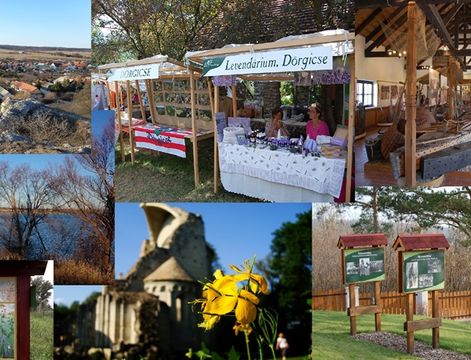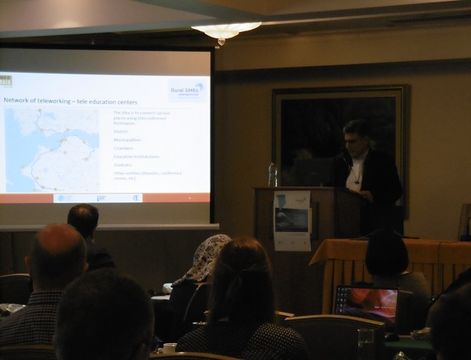
Romania - Digital Innovation Hub
Launch of Digital Innovation Hub (called DIH4S) in Romania
The key policy instruments linked to Investments and Growth are managed mostly from the main cities (regional or national capitals), often disconnected to rural areas, and have less impact in areas of lower population density, in particular the actions towards innovation of the SMEs.
The promotion of entrepreneurship spirit has to be further developed in rural areas, and in particular the promotion of new niches of business opportunities, such as “Energy, Environment, Eco-industries, ICT or Social Innovation”.
€1,022,597.00
SME competitiveness
To improve the policies on regional support systems for entrepreneurs through exchange of experiences and identification of good practices, implementing the lessons learnt in regional action plans to increase the creation of innovative SMEs in rural areas.
To achieve this goal the project envisages the identification, transfer and adoption of projects, measures and policies that would contribute to find out solutions to key challenges that face business development in less populated areas, such as:
In particular, and through the organization of 7 Study visits, 4 Workshops & 2 Seminars, involving the partner’s staff and the relevant regional stakeholders, the project will focus on supporting measures linked to:
This new policy instrument for the period 2014-2020 in the Spanish region of Castilla y León includes six different priority axes related with the thematic objectives corresponding mainly to the smart and sustainable growth pillar of the Europe 2020 Strategy. The project Rur@l SMEs affects directly to the priority axe number three (“Improving SMEs competitiveness”).
On these grounds, the project is related directly with the three main priorities of investment:
3.1. Promotion of entrepreneur spirit.
3.2. Development and application on new market models
3.3. Support to the economic capacity of SMEs in their innovation process.
Thus, this priority axe is based in two core topics: entrepreneurship promotion and establishment and development of new business. The funding allocated to this priority axe in our Operational Programme is around 83 M€.
Regarding to the main reasons for this policy improvement these are related with the lack of concrete focus in rural areas. The policy should be enriched with measures addressing the demographic reality of the region and the necessities of enterprises located in these areas, since rural SMEs barriers to business growth differ geographically.
The purpose of the Local Economic and Development Plan (LECP) for County Tipperary is to set out, for a 6 year period, the objectives and actions needed to promote and support the economic, the local and community development of the county, both by the County Council itself directly and in partnership with other relevant stakeholders in the county. There is no specific funding allocated to the policy instrument, however, it does elaborate a framework by which funding is spent by local actors
All local authorities in Ireland are required to make a LECP as per the Local Government Reform Act 2014. The first County Tipperary LECP was completed in January 2016 and covers the period to 2020. The statutory requirement to adopt the Tipperary LECP is an important measure at the local level in the Irish Government’s overall National Action Plan for Jobs
The LECP contains a high-level economic priority and associated strategic actions of direct relevance to the Rur@l SMEs project as follows:
• LECP High-Level Economic Priority1 : To promote and enable appropriate economic development opportunities throughout the county
• Strategic Action E1.3: Promotion and support of smaller indigenous economic opportunities in all appropriate settlements in the county and micro-enterprise opportunities in all parts of the county, including rural areas
The policy instrument needs to be improved to incorporate practical solutions for SMEs in rural areas to exploit the innovation support system
Operational Programme for the Implementation of the EU cohesion Policy 2014-2020 is a centralised OP for territorial development of Slovenia, covering all 11 Thematic Objectives.
Our goal is to improve Priority 9: “CLLD with specific goal better economic and social inclusion of the society, where creation of entrepreneurial activities and innovative development partnerships.
The new business opportunities in the countryside has to be further fostered and developed; specific emphasis has to be on support to creation of innovative SMEs in the countryside. On the basis of the data from 2013 there is a lack of financial mechanisms for start-ups and also lack of entrepreneurial culture, more aggravated in the rural areas.
The programme should be better developed in themes that concerns the:
- creation of entrepreneurial activities and innovative development partnerships
- specific measures and services for encouragement of the entrepreneurship in rural areas.
Especially is important to tackle the issue of young entrepreneurs in countryside where specific attention need to be given to the young with potentials, women and other vulnerable groups that are facing threat of social exclusion that has little or no opportunities for the development of own entrepreneurial ideas due to lack of knowledge and different skills needed for successful start ups.
The policy instrument addressed above is the first priority axis in Regions operational program 2014-2020 with a total budget of 70,4 m.€ , making obvious the need to be further supported and improved.
The reasons it should be improved are:
i) The vision for Western Greece as described in the operational program 2014-2020 is to become an innovation pole for scientists, researchers and SMEs. In that framework support will be given to entrepreneurs, SMEs and clusters especially in cases that innovation is embedded in the value chains. SMEs have been identified as a key factor not only for the improvement of competitiveness of the Region but also as a necessary condition for the recovery of regional economy and labor market.
ii) A recent analysis (2014) of the Greek Ministry of Development shows that Western Greece has a very strong concentration of workers in the rural areas and agriculture ( 9th among 272 European regions) – as also in SMEs workers( 26th among 272 European regions). Having these in mind the Region’s rural SME’s play a significant role to the reconstruction of Region’s productive base .
iii) Τhe implementation of RIS3 strategy till now in the Region has highlighted the importance of supporting rural SMEs in a more holistic approach, establishing links with research institutes and commerce organizations. It’s remarkable the consensus of all the regional research and commerce players to focus on the rural SMEs as the locomotive of a sustainable development.
Within Széchenyi 2020, the Economic Development and Innovation Operation Programme (GINOP) is dealing with the issue of the project. The policy instrument related to the approach called Needs of territories with serious environmental or demographic unbalance.
The core aim of this approach that the disadvantaged territories find external and gain internal resources to catch up and renew.
1.priority: Develop the competitiveness and employment of businesses
3.priority: ICT developments
5.priority: Employment encouraging and develop the business adaptability
The policy instrument should be developed based on territorial point of view. The operative programme mainly appoints sectoral development priorities and it has no exact territorial context. With the help of the project our agency could analyse and classify the most disadvantageous rural areas and make different suggestions based on the local needs.
The allocated fund of this priority axis is 1 344 675 091 €. (Development of SMEs’ competitiveness and employment enhancing)
The Competitiveness Operational Programme (COP), in Romania, address the challenges stemming from the low support for research, development and innovation (RDI) and the under-developed information and communication technologies (ICT) services and infrastructure. By investing in these areas, the COP aims to contribute to bolster the competitiveness of the Romanian economy
The Programme focus on 2 main priorities:
A1.Research, development and innovation supporting economic competitiveness and the development of businesses (Budget € 952.57 million)
A2.Information and communication technologies for a competitive digital economy investments (Budget € 630.2 million)
Policy instruments oriented on encouraging investments and growth are usually managed by the cities capital of regions or country not very well connected to the rural areas. Many rural business, in Romania, suffer from insufficient access to innovation structures and knowledge, finance, communication, logistics, etc) hence good practices, from different European regions, need to be promoted to local stakeholders (including authorities), to increase their capacity to initiate/ manage entrepreneurial activities and stimulate the creation of networks and clusters for developing new products and services in rural areas
The policy instrument is not reaching enough the stakeholders from rural areas and it needs to have a better approach to entrepreneurship initiatives and business development opportunities in these areas
The municipalities integrating CIM Ave are implementing this policy instrument for Ave Region that is operated under CIM Ave responsibility.
The main objective of the policy instrument is to enhance the competitiveness of enterprises, and to strengthen the region competitiveness by promoting the investment in innovation, R&D and diversifying and strengthening SMEs, with the aim of increasing participation in the processes of growth and innovation.
The priorities of this policy instrument are:
- Stimulating entrepreneurship by facilitating the support for the economic exploitation of new ideas and fostering the creation of new enterprises, including through business incubators;
- Developing and applying new business models for SMEs,
The reasons for the improvement of the policy instrument addressed are:
- Innovative activities that must involve rural/peri-urban areas, currently lagging behind the main urban centres
- SMEs in the Ave Region are facing viability challenges, not only due to the outbreak of the financial crisis, but also due to the low integration of R&D results. To this end, the region acknowledges the need to develop innovation support services, so that SMEs can exploit new technologies and models to develop innovative products and have access to new markets.
- Promote less bureaucratic procedures and low speed of evaluation and funding processes that are the main obstacles for growth/innovation faced by rural economy SMEs in the region

Launch of Digital Innovation Hub (called DIH4S) in Romania

Hungary focuses on social enterprises with a focus on women

The Region of Western Greece is successful in influencing Entrepreneurship Policy

Policy makers and practitioners came together to discuss how policy and support measures could be enhanced for rural SMEs.

Each tree, each bush, each shrub is a mediator between the ground and the atmosphere. Without these two agents together, there is just a hollow field!

The below infographic shows the most relevant projects related to rural SMEs and rural innovation

It is not prudent to become a farmer for the sake of earning money only, this job can be done only if one is passionate about animals

Financial tools for innovative Rural SME’s

Central role of the farming community and the impact of climate change.

Addressing geographical challenges using teleconferencing